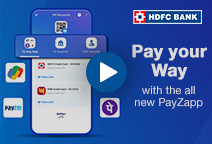You've Been Logged Out
For security reasons, we have logged you out of HDFC Bank NetBanking. We do this when you refresh/move back on the browser on any NetBanking page.
OK- Home
- PAY Cards, Bill Pay
- Money Transfer
- To Other Account
- To Own Account
- UPI (Instant Mobile Money Transfer)
- IMPS (Immediate Payment 24 * 7)
- RTGS (Available 24 * 7)
- NEFT (Available 24 * 7)
- RemitNow Foreign Outward Remittance
- Remittance (International Money Transfers )
- Religious Offering's & Donation
- Visa CardPay
- RemitNow (For Expat)
- Forex Services for students
- Pay your overseas education fees with Flywire
- ESOP Remittances
- Cards
- Bill Payments
- Recharge
- Payment Solutions
- Money Transfer
- SAVE Accounts, Deposits
- INVEST Bonds, Mutual Funds
- BORROW Loans, EMI
- INSURE Cover, Protect
- OFFERS Offers, Discounts
- My Mailbox
- My Profile
- Home
- PAY Cards, Bill Pay
- Money Transfer
- To Other Account
- To Own Account
- UPI (Instant Mobile Money Transfer)
- IMPS (Immediate Payment 24 * 7)
- RTGS (Available 24 * 7)
- NEFT (Available 24 * 7)
- RemitNow Foreign Outward Remittance
- Remittance (International Money Transfers )
- Religious Offering's & Donation
- Visa CardPay
- RemitNow (For Expat)
- Forex Services for students
- Pay your overseas education fees with Flywire
- ESOP Remittances
- Cards
- Bill Payments
- Recharge
- Payment Solutions
- Money Transfer
- SAVE Accounts, Deposits
- INVEST Bonds, Mutual Funds
- BORROW Loans, EMI
- INSURE Cover, Protect
- OFFERS Offers, Discounts
- My Mailbox
- My Profile
- Home
- PAY Cards, Bill Pay

- Money Transfer
- To Other Account
- To Own Account
- UPI (Instant Mobile Money Transfer)
- IMPS (Immediate Payment 24 * 7)
- RTGS (Available 24 * 7)
- NEFT (Available 24 * 7)
- RemitNow Foreign Outward Remittance
- Remittance (International Money Transfers )
- Religious Offering's & Donation
- Visa CardPay
- RemitNow (For Expat)
- Forex Services for students
- Pay your overseas education fees with Flywire
- ESOP Remittances
- SAVE Accounts, Deposits
- INVEST Bonds, Mutual Funds
- BORROW Loans, EMI
- INSURE Cover, Protect
- OFFERS Offers, Discounts
- My Mailbox
- My Profile
- Personal
- Resources
- Learning Centre
- ThisPageDoesNotCntainIconPay
- Difference Between Neft and Rtgs
Difference Between Neft and Rtgs?

04 January, 2024
Online fund transfer processes like National Electronic Funds Transfer (NEFT) and Real Time Gross Settlement (RTGS) play an important role in a nation’s digital payment ecosystem. Not only do they allow instant transfer of funds between bank accounts, but they also ensure that businesses and individuals can make timely transactions. This improves overall economic efficiency as well. So, it is essential for you to have a clear understanding of the significant distinctions between these two types of money transfers. Let us understand what is NEFT and RTGS and see how these two payment methods differ.
What is National Electronic Funds Transfer (NEFT)?
Regulated by the Reserve Bank of India (RBI); the country’s central bank, National Electronic Fund Transfer or NEFT is an electronic or online method of transferring money between accounts. NEFT allows you to conveniently transfer funds from your one bank account to another, permitting inter and intra bank transfers. Here are some of the key features of an NEFT transaction.
Transaction Limit: With NEFT, you can initiate fund transfers of any amount. There is no upper or lower limit on the transaction amount.
Settlement Time- NEFT transactions are processed in separate batches and it can take anywhere from 30 minutes to 2 hours for your beneficiary to receive the funds in their account.
Transfer Timings- You can initiate NEFT transactions 24*7, all 365 days of the year, including on weekends and public holidays, without worrying about bank hours.
Mode of Transfer: NEFT transactions can be performed both online and offline. In case of the latter, you need to visit your bank to conduct the transfer.
Charges: Per the RBI, banks cannot levy any charges on online transfers, however, they are permitted to levy a nominal charge for offline transfers conducted at the bank.
What is Real-Time Gross Settlement (RTGS)?
Like NEFT, RTGS is also another type of fund transfer method. However, this mode of fund transfer is especially designed for individuals and businesses who need to conduct high-value transactions. RTGS is also regulated by the NEFT and fund transfers are conducted in real-time, which means the beneficiary receives the sums in their account within minutes. Some salient features of RTGS are as under:
Transaction Limit: With RTGS, you need to transfer at least ₹2 lakh per transaction, with no specific upper limit on the amount you can transfer.
Settlement Time: RTGS transactions are processed on a one-to-one basis and settled immediately, ensuring real-time transfer of funds.
Transfer Timings: Like NEFT, you can initiate RTGS transactions at any time of the day, all year round, using both online and offline modes.
Charges: Banks levy nominal charges on RTGS fund transfer, ranging from ₹20 to ₹40 (plus GST), based on the transfer amount.
NEFT and RTGS – Prerequisites for Fund Transfers
When initiating NEFT and RTGS transactions, you need to provide some vital details about the beneficiary and their bank account. These include:
The beneficiary’s name
The beneficiary's bank and branch name
The beneficiary’s bank account number and IFSC code
The beneficiary's contact number
Note that if you are setting up a beneficiary account for the first time, you need to wait for at least 30 minutes before initiating the fund transfer.
NEFT vs RTGS – A comparison
Having explained what is NEFT and RTGS and their specific features, it is now time to compare their differences. The primary differences between NEFT and RTGS include:
Settlement Speed: NEFT operates on a deferred settlement mode, where transactions are processed and settled in batches. The settlements take place in hourly intervals. Conversely, RTGS settles transactions in real time, meaning the funds are instantly transferred into beneficiary accounts.
Purpose: RTGS is designed specifically to enable customers to make high-value transactions like paying for properties or business transactions. On the other hand, you can use NEFT to transfer amounts as low as ₹1. Note that while the RBI has not designated a maximum NEFT transaction limit, banks may set limits on the maximum sum you can transfer.
Consider the below tabular representation of the differences between NEFT and RTGS.
Basis of Distinction | NEFT | RTGS |
Settlement | Batch-wise settlement at set intervals generally taking 1-2 hours. | Real-time and individual settlement i.e., instant transfer. |
Minimum Amount | No Set limit | ₹2 lakhs |
Suitability | NEFT is suitable for relatively smaller fund transfer amounts. | RTGS is ideal if you wish to transfer sums exceeding ₹2 lakhs. |
Click here for quick fund transfer through PayZapp on your IOS phone.
Click here to send money through PayZapp on your Android phone.
NEFT or RTGS – Which is Faster or Better?
Both NEFT and RTGS have their own merits. In a sense, you can transfer funds via either method, especially in case of high value transaction. RTGS is ideal if you need to send money during a financial emergency. For instance, if you wish to send money to a loved one getting admitted to a hospital, you can consider RTGS for its real-time settlement benefit. However, if your beneficiary can wait for up to 2 hours, and you do not wish to pay a fund transfer fee, you can always consider an NEFT transfer.
Transfer Funds Instantly via PayZapp
Like NEFT and RTGS, HDFC Bank’s PayZapp is a real-time fund transfer facility. PayZapp doubles as an online payment solution and a digital wallet, allowing you to transfer money and initiate payments. Through PayZapp, you can pay your utility bills, recharge your devices, book travel tickets and hotel accommodations, etc. Just link your HDFC Bank or other bank account or Debit Card/Credit Card to PayZapp to initiate instant online transactions. Know more about PayZapp.
*Terms and conditions apply. The information provided in this article is generic in nature and for informational purposes only. It is not a substitute for specific advice in your own circumstances.
| Related Searches | |||
| payment app | pay electricity bill online | ||
| upi | utr number check | ||
| money transfer app | what is payments | ||




